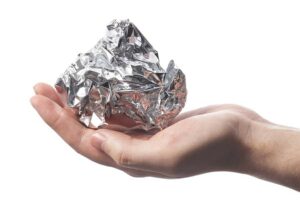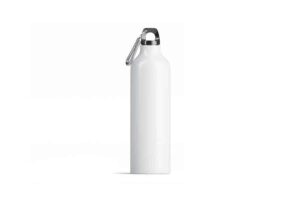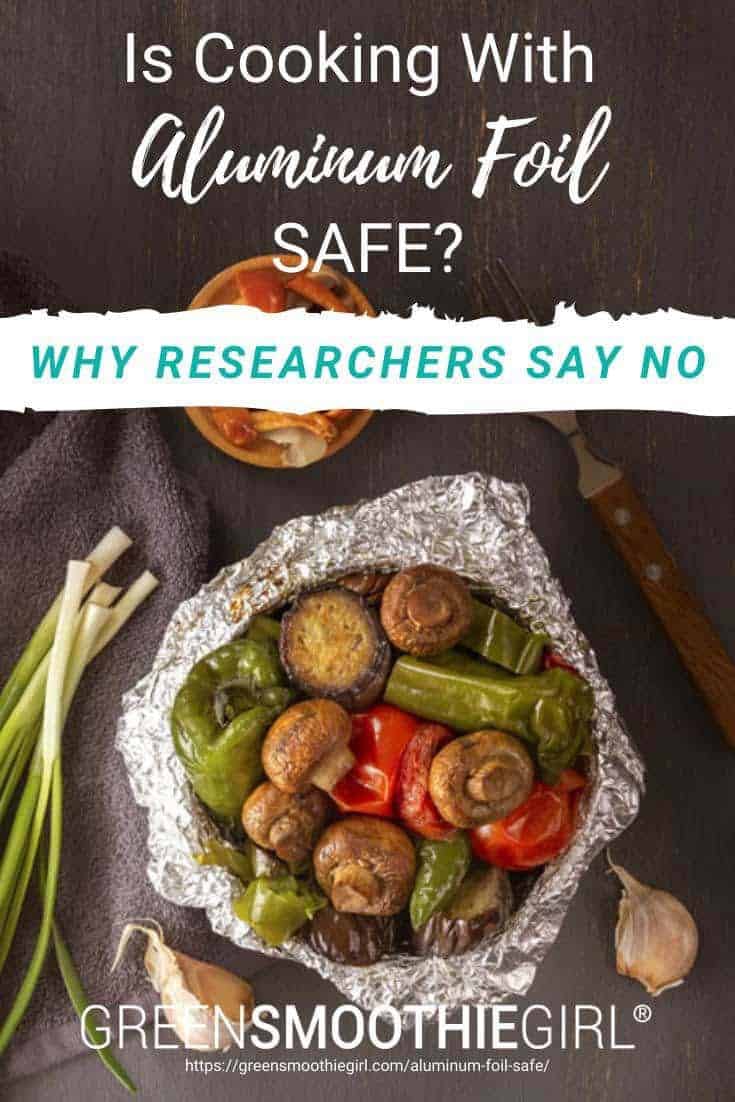Is Cooking With Aluminum Foil Safe? Why Researchers Say No

Like most households in America, yours may have a roll of aluminum foil at hand that you use for storing food, lining broiler pans, or wrapping up meats, fish, and vegetables before baking or grilling them. It’s a handy item that millions of Americans use to make both grilling and clean-up easier.
There is a growing concern, however, that the aluminum foil we regularly use often leaches into our food, risking our health from this known neurotoxin. In fact, studies show that aluminum foil doesn’t even have to touch food to be a health hazard, because aluminum production is so environmentally toxic.
In this article:
- Does Aluminum From Foil Leach Into Food?
- What Are The Health Risks Associated With Aluminum?
- Other Sources of Aluminum
- Where Does Aluminum Come From?
- Aluminum And The Environment
- Can You Recycle Aluminum Foil?
- What Can I Use Instead Of Aluminum Foil For Cooking?
- Clearing Aluminum From Your Body
Does Aluminum From Foil Leach Into Food?
In 2012, a study using three techniques for analysis clearly revealed that yes, “the use of aluminum foil for cooking contributes significantly to the daily intake of aluminum through the cooked foods.” They also found higher levels with the addition of acidic solutions that included apple cider vinegar and tomato juice, as well as with some spices.2
The high levels of aluminum found in the food exceeded the safety limits of both the European Food Safety Authority (EFSA), and even the World Health Organization (WHO), whose limits are twice that of EFSA’s.3
The researchers’ conclusion was that aluminum foil may be used for storing food, but not for cooking, and that excessive consumption from leaching aluminum foil can create extreme health risks.

Aluminum comes in more forms than foil -- decrease your health risk by eliminating all the forms you can.
What Are The Health Risks Associated With Aluminum?
Research suggests that, as aluminum accumulates in the body, it has the potential to damage bones, kidneys, and the nervous systems.5 It is also a potent pro-oxidant that produces an excessive number of free radicals—the errant, highly-reactive unstable atoms that damage cells. Ultimately, this oxidative stress leads to premature aging and numerous chronic conditions such as cancer, diabetes, cardiovascular diseases, and chronic inflammation.6
Let’s take an in-depth look at a few of the harmful effects associated with aluminum.
Osteoporosis
Aluminum and other heavy metals can replace calcium in bone mineralization—making bones more brittle. Most people don’t know that aluminum is a key ingredient in antacids, and disrupts the metabolism of calcium and phosphorus, two important minerals involved in the formation of bones—this interference ultimately results in bone loss.7
Male Infertility
According to research conducted at Universities in both France and the U.K., exposure to aluminum may be a significant factor in reduced sperm counts and male infertility.8 Scientists found that the higher the aluminum levels in donors, the lower the sperm count.
[Related: How EMF Affects Sperm, And How To Protect Yourself]
Alzheimer’s
Aluminum is a known neurotoxin. This means that aluminum acts as a poison to the nervous system, which can result in damage to neurons. Research also demonstrates that aluminum accumulates in the brain as we age, and that a significant percentage of people older than 70 have accumulated enough to correspond with detectible neurogenerative disease (like Alzheimer’s) somewhere in their brain.9
While this theory has been heavily disputed, research reveals that only very small amounts of aluminum are needed to produce neurotoxicity and that it is possible to acquire this amount through exposure in the diet. Since 1911, evidence has accumulated that demonstrates this connection. According to Neural Dynamics Research Group in Canada, “Immediate steps should be taken to lessen human exposure to aluminum, which may be the single most aggravating and avoidable factor related to Alzheimer’s disease.”10
Breast Cancer
The connection between aluminum salts in antiperspirants and whether they contribute to breast cancer has been an ongoing debate for years. In my opinion, enough evidence has mounted that I choose to use natural deodorants or crystal deodorant sticks. The use of aluminum foil in cooking or keeping foods in the refrigerator just adds to the overall toxic body burden and the accumulation of this heavy metal, so it seems wise to limit your exposure to aluminum in as many ways as possible.
One study reported in the Journal of Applied Toxicology found that long-term exposure to aluminum chloride in concentrations that are 100,000-fold lower than the amount found in antiperspirants, resulted in “anchorage-independent growth”—the ability of cells to divide and spread without being attached to a specific surface, which is one of the hallmarks of cancer cells. The researchers concluded that their “observations do not formally identify aluminum as a breast carcinogen, but challenge the safety ascribed to its widespread use in underarm cosmetics.11
Another report in the Journal of Inorganic Biochemistry reviewed evidence linking aluminum with breast cancer. The report included the fact that aluminum has been detected in breast tissue in higher levels than those found in blood serum; and that evidence suggests that the level measured can encourage “anchorage-independent proliferation” as well as estrogen action.
Aluminum also causes disruption in iron metabolism, oxidative damage, and an inflammatory response—changes that are associated with cancer and metastatasis.12
The truth is that aluminum is found in a host of products, making foil used in the kitchen just one more way we may be inadvertently increasing our exposure to this heavy metal.
Other Sources of Aluminum
Aluminum can be found in the food we eat, the water we drink, and the air we breathe. It’s also evident in antacids, deodorants, some pots and pans, utensils, and cans:
- Air—With aluminum being such an abundant metal, found in rocks, soil, and water, it’s clear that we will also find it in the air. You will increase your exposure if you smoke cigarettes or cannabis, or use drugs such as cocaine. I use an indoor air filter in my home—it’s quiet and innocuous--and I have eliminated all chemical personal care products, fragrances, and cleaning products. Luckily, these days, you have many non-toxic options.

Air filters in your home decrease the aluminum in your air.
[Related: Non-toxic Laundry Products You Don’t Have To Make Yourself]
- Diet—Dietary measurements of aluminum have varied from 1 mg to more than 20 mg per day.13 This metal is particularly prolific in soy, due to industrial washing. The beans are soaked in harsh alkaline solutions that leach aluminum from the processing equipment and is abundant in “modern” soy foods such as soy protein concentrates, textured soy protein, soy protein shakes, and soy supplements.14
Aluminum is also abundant in processed, fast food. Researchers found aluminum in all analyzed samples of fast food with elevated levels in pork- and chicken-based foods as well as foods with spices, herbs, additives, and of course, those wrapped in aluminum foil.15
- Vitamins—Risk of aluminum exposure is just one of the many reasons why I recommend getting your nutrients from whole, organic food. Vitamins often contain toxic ingredients--one of these being aluminum. When researchers tested 26 commonly used prenatal vitamin brands, all of them contained detectable levels of aluminum.16
- Deodorant—Aluminum salts are an active ingredient in most deodorants. If you are using commercial antiperspirants, you are applying about 2 g of aluminum to your skin every day. It is also found in sunscreen and body lotion as well as other cosmetics. While some prefer non-toxic deodorants, and others (myself included) use crystal sticks, many who are aware of this issue gave up commercial deodorants and anti-perspirants many years ago.
[Related: Cosmetic Ingredients To Avoid]
- Medicine—Aluminum is found as an added component in several types of medicines which include antacids and buffered aspirin. It’s also found in medicinal remedies for allergy symptoms.17
- Aluminum Cans—Worldwide, we go through about 6,700 aluminum cans every second. Yes, you read that right…every second! This adds up to 200 billion aluminum cans every year.18
Interestingly, more damaging than the aluminum we may be ingesting, is the BPA—a toxin associated with plastics. Researchers found that when adults drank soy milk from either a can or a glass bottle, those who drank from cans had up to 1600 percent higher BPA urine levels than those that drank out of glass.19

Drinking from aluminum bottles or straws causes you to ingest up to 1600% more BPA than glass alternatives.
Toxic Overload
It’s evident that aluminum, as with most heavy metals, adds to our “chemical body burden”—the environmental toxins that have accumulated throughout our lifetime.
[Related: Your Child’s Toxic Body Burden: What A Holistic Pediatrician Wants You To Know]
But this toxic overload isn’t just affecting us, it’s affecting our planet as well, and all lifeforms that dwell among us. In order to fully understand the consequences, we must look into just how we obtain this aluminum that has become a household staple.
Where Does Aluminum Come From?
Aluminum is the most abundant metal on Earth, making up about 8.1 percent of its crust. It is found in minerals that are known as aluminum silicates such as bauxite and cryolite. Developing the process for extracting aluminum from these minerals has made aluminum the most widely used metal of the 21st century.
It also takes more energy to mine and produce aluminum than any other metal.18
As with most mining operations, plant and animal life in the immediate area is affected for multiple generations. Trees are clear-cut, habitat is lost, and erosion occurs.
Then there is the refining process, the bauxite ore that, through chemical processes, eventually creates the thick chalk dust known as powdery alumina. It requires high amounts of electricity and water which causes higher carbon emissions, which creates air and water pollution, before becoming pure, molten, aluminum.20
North America goes through more than 22 billion pounds of aluminum every year and has experienced a 40 percent increase in demand since the great depression of 2009. In 2019, our production levels are up 40 percent from the same time frame in 2018.
Where does all this aluminum end up?

Alumina powder takes lots of energy and water to becomes molten aluminum, which increases pollution.
Aluminum And The Environment
Aluminum foil takes about 400 years to break down. Yes, it is recyclable, but no, most people don’t bother to separate aluminum foil from their other trash—so most of it is ending up in landfills or oceans.
The increasing aluminum in the environment is also affecting animals.
The bee population decline is a worldwide concern. Scientists have found that bee’s brains contain a high level of aluminum—anywhere from 13 to 200 parts per million (ppm). As a comparison, in humans, 3 ppm in the brain is considered dangerous. Due to the accumulation of this neurotoxin, bees are presenting with a type of dementia called aluminum-induced cognitive dysfunction.5
In addition, the increasing environmental aluminum leads to acidified surface waters and soil, resulting in the death of fish and trees.
Restoring a healthy eco-environment involves using less and recycling more. The good news is that, unlike plastic and if uncontaminated, aluminum can be recycled indefinitely.
Can You Recycle Aluminum Foil?
Did you know that Americans make up about 5 percent of the world’s population, but account for 30 percent of the world’s trash? Included in the 1 million pounds of waste we produce per person every year is recyclable aluminum and, though recyclable, we throw away enough aluminum every year to rebuild the entire commercial air fleet every three months.20

Recycled aluminum cans take only 5% of the energy to make compared to new ones.
Although aluminum cans are 100 percent recyclable, currently, Americans throw away about half of the cans they use.
A new can may be made from an old one in as little as sixty days after finding its way into the recycle bin, and producing aluminum from recycled cans takes just 5 percent of the energy needed to produce new aluminum.21
Aluminum foil, on the other hand, is a little more difficult to recycle in that it needs to be wiped clean before being put in the recycling bin.
You can buy recycled aluminum foil, if you have instances where nothing else will do, but there are other options.
What Can I Use Instead Of Aluminum Foil For Cooking?
Aluminum foil has become so ubiquitous in our society that it may seem living without it would be extremely difficult. There are, however, easy alternatives—ones that will benefit both your health and the environment.
Consider the following:
- Use reusable skewers for grilling vegetables. (On another note, I threw out my barbecue decades ago due to the negative health effects associated with grilling, but that’s for another post).
- Use stainless steel baking sheets and glass or porcelain pans for roasting.
- Use alternatives for wrapping food when baking such as cedar grilling papers, and even banana leaves are becoming more mainstream as baking wraps.

Glass pans for roasting, reusable skewers for grilling, and banana leaves for wrapping are all great alternatives to using aluminum foil when making food.
Clearing Aluminum From Your Body
As you find alternatives to the use of products containing aluminum and reduce your other exposure factors, it’s time to ease the toxic burden that has accumulated in your body. You can use a fulvic and humic acid mineral product to help bind to and sweep out heavy metals like aluminum from your body. Consider undergoing a detox program once or twice a year to cleanse and rejuvenate, enabling you to live your life at the highest vibrational level.
READ NEXT: Drink Wine, Drink Roundup: Why “Safe” Levels Aren’t

Disclosure: This post may contain affiliate links that help support the GSG mission without costing you extra. I recommend only companies and products that I use myself.
Resources
- Usage of Aluminum foil in the U.S. 2019. Statista. 08/2019. https://www.statista.com/statistics/275417/us-households-usage-of-aluminum-foil/
- Bassioni, Ghada et al. Risk Assessment of Using Aluminum Foil in Food Preparation. International journal of electrochemical science. 05/2012. https://www.researchgate.net/publication/221971690_Risk_Assessment_of_Using_Aluminum_Foil_in_Food_Preparation
- Joint FAO/WHO Expert Committee on Food Additives. Food and Agriculture Organization of the United Nations and the World Health Organization. 06/2011. http://www.fao.org/3/a-at873e.pdf
- Aguilar, F. et al. Scientific Opinion of the Panel on Food Additives, Flavorings, Processing Aids and Food Contact Materials. 05/2008. https://efsa.onlinelibrary.wiley.com/doi/epdf/10.2903/j.efsa.2008.754
- Munoz, Garbriella. The Dangers of Aluminum Foil. Sciencing. 04/2018. https://sciencing.com/dangers-aluminum-foil-8314412.html
- Exley, Christopher. The pro-oxidant activity of aluminum. Free Radical Biology and Medicine. 02/2004. https://www.sciencedirect.com/science/article/pii/S0891584903007937?via%3Dihub
- Kramer, Spencer H. Osteoporosis: calcium, fluoride, and aluminum interactions. Journal of the American College of Nutrition. 04/1985. https://www.ncbi.nlm.nih.gov/pubmed/3886758
- Exposure to aluminum may impact on male fertility, research suggests. Science Daily. 10/2014. https://www.sciencedaily.com/releases/2014/10/141021085114.htm
- Exley, C. What is the risk of aluminum as a neurotoxin? Expert Review of Neurotherapeutics. 06/2014. https://www.ncbi.nlm.nih.gov/pubmed/24779346
- Tomljenovic, L. Aluminum and Alzheimer’s disease: after a century of controversy, is there a plausible link? Journal of Alzheimer’s disease. 04/2011. https://www.ncbi.nlm.nih.gov/pubmed/21157018
- Sappino, Andre-Pascal et al. Aluminium chloride promotes anchorage-independent growth in human mammary epithelial cells. Journal of Applied Toxicology. 01/2012. https://onlinelibrary.wiley.com/doi/abs/10.1002/jat.1793
- Darbre, Philippa D. et al. Aluminium and breast cancer: Sources of exposure, tissue measurements and mechanisms of toxicological actions on breast biology. Journal of Inorganic Biochemistry. 11/2013. https://www.sciencedirect.com/science/article/pii/S0162013413001608?via%3Dihub
- Exley, Christopher. Human Exposure to Aluminium. Royal Society of Chemistry. 08/2013. https://pubs.rsc.org/en/content/articlehtml/2013/em/c3em00374d#cit12
- Friedman, David Dr. Food Sanity. Basic Health Publications. 2018.
- Lopez, Francisco F. et al. Aluminum levels in convenience and fast foods: in vitro study of the absorbable fraction. Science of Total Environment. 12/2002. https://www.sciencedirect.com/science/article/pii/S0048969702002826?via%3Dihub
- Schwalfenberg, Gerry et al. Heavy metal contamination of prenatal vitamins. Toxicology Reports. 03/2018. https://www.ncbi.nlm.nih.gov/pmc/articles/PMC5978005/
- May, Joan C. et al. The aluminum coneant of biological products containing aluminum adjuvants: Determination by atomic absorption spectrometry. Journal of Biological standardization. 04/1984. https://www.sciencedirect.com/science/article/pii/S0092115784800517?via%3Dihub
- Aluminum Cans Facts. The World Counts. https://www.theworldcounts.com/counters/world_food_consumption_statistics/aluminium_cans_facts
- Cantor, Matt. Why Drinking From a Can May be Dangerous. USA Today. 12/2014. https://www.usatoday.com/story/news/nation/2014/12/14/bottle-chemical-bpa-health-newser/20397547/
- The Environmental Impact of Aluminum (And Why It’s Still Better Than Plastic. Student Conservation Association. https://www.thesca.org/connect/blog/environmental-impact-aluminum-and-why-it%E2%80%99s-still-better-plastic
- What Can I Recycle. Waste Management. https://www.wm.com/thinkgreen/what-can-i-recycle.jsp
Posted in: Health Concerns, Preventive Care















